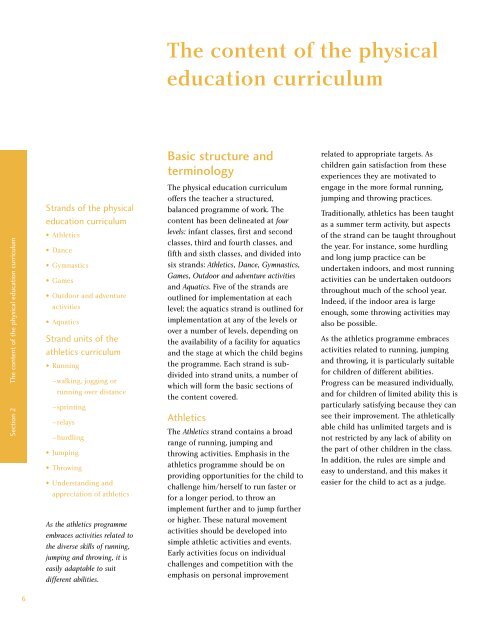PE_Guidelines_english0
You also want an ePaper? Increase the reach of your titles
YUMPU automatically turns print PDFs into web optimized ePapers that Google loves.
The content of the physical<br />
education curriculum<br />
Section 2 The content of the physical education curriculum<br />
Strands of the physical<br />
education curriculum<br />
• Athletics<br />
• Dance<br />
• Gymnastics<br />
• Games<br />
• Outdoor and adventure<br />
activities<br />
• Aquatics<br />
Strand units of the<br />
athletics curriculum<br />
• Running<br />
–walking, jogging or<br />
running over distance<br />
–sprinting<br />
–relays<br />
–hurdling<br />
• Jumping<br />
• Throwing<br />
• Understanding and<br />
appreciation of athletics<br />
As the athletics programme<br />
embraces activities related to<br />
the diverse skills of running,<br />
jumping and throwing, it is<br />
easily adaptable to suit<br />
different abilities.<br />
Basic structure and<br />
terminology<br />
The physical education curriculum<br />
offers the teacher a structured,<br />
balanced programme of work. The<br />
content has been delineated at four<br />
levels: infant classes, first and second<br />
classes, third and fourth classes, and<br />
fifth and sixth classes, and divided into<br />
six strands: Athletics, Dance, Gymnastics,<br />
Games, Outdoor and adventure activities<br />
and Aquatics. Five of the strands are<br />
outlined for implementation at each<br />
level; the aquatics strand is outlined for<br />
implementation at any of the levels or<br />
over a number of levels, depending on<br />
the availability of a facility for aquatics<br />
and the stage at which the child begins<br />
the programme. Each strand is subdivided<br />
into strand units, a number of<br />
which will form the basic sections of<br />
the content covered.<br />
Athletics<br />
The Athletics strand contains a broad<br />
range of running, jumping and<br />
throwing activities. Emphasis in the<br />
athletics programme should be on<br />
providing opportunities for the child to<br />
challenge him/herself to run faster or<br />
for a longer period, to throw an<br />
implement further and to jump further<br />
or higher. These natural movement<br />
activities should be developed into<br />
simple athletic activities and events.<br />
Early activities focus on individual<br />
challenges and competition with the<br />
emphasis on personal improvement<br />
related to appropriate targets. As<br />
children gain satisfaction from these<br />
experiences they are motivated to<br />
engage in the more formal running,<br />
jumping and throwing practices.<br />
Traditionally, athletics has been taught<br />
as a summer term activity, but aspects<br />
of the strand can be taught throughout<br />
the year. For instance, some hurdling<br />
and long jump practice can be<br />
undertaken indoors, and most running<br />
activities can be undertaken outdoors<br />
throughout much of the school year.<br />
Indeed, if the indoor area is large<br />
enough, some throwing activities may<br />
also be possible.<br />
As the athletics programme embraces<br />
activities related to running, jumping<br />
and throwing, it is particularly suitable<br />
for children of different abilities.<br />
Progress can be measured individually,<br />
and for children of limited ability this is<br />
particularly satisfying because they can<br />
see their improvement. The athletically<br />
able child has unlimited targets and is<br />
not restricted by any lack of ability on<br />
the part of other children in the class.<br />
In addition, the rules are simple and<br />
easy to understand, and this makes it<br />
easier for the child to act as a judge.<br />
6



